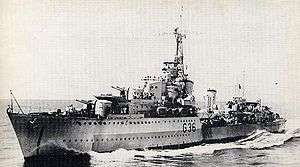HMS Nubian (F36)
 HMS Nubian (F36), late in World War II | |
| History | |
|---|---|
| Name: | Nubian |
| Namesake: | Nubians |
| Ordered: | 10 March 1936 |
| Builder: | Thornycroft, Southampton |
| Cost: | £339,265 |
| Laid down: | 10 August 1936 |
| Launched: | 21 December 1937 |
| Completed: | 7 December 1938 |
| Commissioned: | October 1938 |
| Identification: | Pennant number: L36, later F36 |
| Fate: | Scrapped, 1949 |
| General characteristics (as built) | |
| Class and type: | Tribal-class destroyer |
| Displacement: | |
| Length: | 377 ft (115 m) (o/a) |
| Beam: | 36 ft 6 in (11.13 m) |
| Draught: | 11 ft 3 in (3.43 m) |
| Installed power: |
|
| Propulsion: | 2 × shafts; 2 × geared steam turbines |
| Speed: | 36 knots (67 km/h; 41 mph) |
| Range: | 5,700 nmi (10,600 km; 6,600 mi) at 15 knots (28 km/h; 17 mph) |
| Complement: | 190 |
| Sensors and processing systems: | ASDIC |
| Armament: |
|
HMS Nubian was a Tribal-class destroyer of the British Royal Navy that saw much distinguished service in World War II. She won 13 battle honours, a record only exceeded by one other ship, and matched by two others.
Service history
Nubian was in home waters for the early part of the Second World War, and saw action with the Home Fleet during the Norwegian Campaign in May 1940.
Following this, Nubian joined 14th Destroyer Flotilla at Plymouth, which was led by Captain P J Mack (temporarily flying his pennant in Janus, whilst has own ship, Jervis, was undergoing repair). Also in the 14th Destroyer Flotilla were Mohawk (another of the Tribal class), and Juno (another J-class destroyer). The flotilla left Plymouth for Alexandria on 18 May 1940, in company with 4 K-class destroyers from the 5th Destroyer Flotilla en route for service in the Red Sea; they arrived in Alexandria on 25 May, just two weeks days before hostilities with Italy commenced on 11 June 1940.
Nubian saw much action, being involved in the actions at Calabria, in July 1940, Matapan (March 1941), Sfax (April), and finally Crete (May). During the battle of Cape Matapan, she delivered the coup de grace to the Italian cruiser Pola, stricken by an aerial torpedo.
_off_Malta_1943.jpg)
During the battle of Crete, on 26 May, Nubian was bombed and had her stern blown off, with the loss of 7 of her crew killed, and another 12 wounded. Despite further attacks, she was able to return to Alexandria under escort, but departed there on 12 June under tow for extensive repairs in Bombay, which were not completed for another 18 months.
Nubian returned to the Mediterranean and the 14th Destroyer Flotilla in November 1942, seeing action with them against the Italian torpedo boat Lupo convoy on 2 December and off Tripoli in company with Jervis on 20–21 December.
In 1943, she was involved with supporting the landings in Sicily, and at Salerno, before returning to Britain for reassignment to the Arctic. While in the Arctic she conducted convoy escort duty, during which she was involved in at least one direct attack on a U-boat, a cat and mouse hunt which lasted some days. She also tracked at least 11 other U-boats that twice attacked the convoy she was shadowing. During operations conducted in the Arctic, she dispatched back to Norway on two vital operations. These were a strike on the German submarine base at Trondheim Fjord, and a strike on the German battleship Tirpitz at Alton Fjord.
At the end of 1944, Nubian was refitted, ready to be dispatched to the Far East in 1945, seeing action in support of the closing operations in Burma, a varied and wide-ranging career.
Battle honours
- Norway 1940
- Calabria 1940
- Mediterranean 1940-43
- Libya 1940
- Matapan 1941
- Sfax 1941
- Greece 1941
- Crete 1941
- Malta Convoys 1941
- Sicily 1943
- Salerno 1943
- Arctic 1944
- Norway 1944
- Burma 1944-45[1]
Two other ships, Orion and Jervis, also serving in the Mediterranean with Nubian, matched this record; it was exceeded only by the Queen Elizabeth-class battleship Warspite, a Jutland veteran and the Mediterranean Fleet flagship through much of the Second World War.
Notes
- ↑ Warlow. Battle Honours of the Royal Navy. p. 155.
References
- G.G.Connell : Mediterranean Maelstrom: HMS Jervis and the 14th Flotilla (1987) ISBN 0-7183-0643-0
- Brice, Martin H. (1971). The Tribals. London: Ian Allan. ISBN 0-7110-0245-2.
- English, John (2001). Afridi to Nizam: British Fleet Destroyers 1937–43. Gravesend, Kent: World Ship Society. ISBN 0-905617-64-9.
- Friedman, Norman (2006). British Destroyers and Frigates, the Second World War and After. Annapolis, Maryland: Naval Institute Press. ISBN 1-86176-137-6.
- Haarr, Geirr H. (2010). The Battle for Norway: April–June 1940. Annapolis, Maryland: Naval Institute Press. ISBN 978-1-59114-051-1.
- Haarr, Geirr H. (2009). The German Invasion of Norway, April 1940. Annapolis, Maryland: Naval Institute Press. ISBN 978-1-59114-310-9.
- Hodges, Peter (1971). Tribal Class Destroyers. London: Almark. ISBN 0-85524-047-4.
- Lenton, H. T. (1998). British & Empire Warships of the Second World War. Annapolis, Maryland: Naval Institute Press. ISBN 1-55750-048-7.
- Rohwer, Jürgen (2005). Chronology of the War at Sea 1939–1945: The Naval History of World War Two (Third Revised ed.). Annapolis, Maryland: Naval Institute Press. ISBN 1-59114-119-2.
- Whitley, M. J. (1988). Destroyers of World War Two. Annapolis, Maryland: Naval Institute Press. ISBN 0-87021-326-1.
- Warlow, Ben (2004). Battle Honours of the Royal Navy: Being the officially authorised and complete listing of Battle Honours awarded to Her/His Majesty's Ships and Squadrons of the Fleet Air Arm including Honours awarded to Royal Fleet Auxiliary Ships and merchant vessels. Cornwall: Maritime Books. ISBN 1-904459-05-6.
- A.E. Weightman : Crests and Badges of H.M. Ships (1957) ISBN (none)